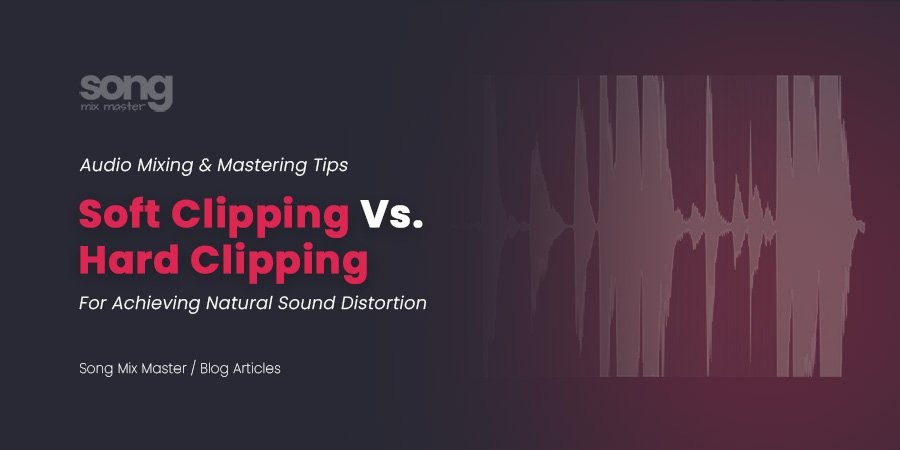I’ve spent countless hours tweaking and fine-tuning sounds to achieve that perfect blend of warmth and clarity. One of the most fascinating aspects of audio production is how we manage distortion, and two key techniques in this realm are soft clipping and hard clipping. These methods aren’t just about controlling the peaks of an audio signal; they shape the very character of the sound in profound ways.
Soft clipping offers a more natural, warm distortion that can add pleasing harmonics and a smooth, rounded feel. On the other hand, hard clipping is more aggressive, cutting off peaks sharply and adding a more pronounced, edgy distortion.
Understanding when and how to use these techniques can make a significant difference in your mixes and masters. In this article, we’ll dive deep into these clipping techniques, exploring their unique characteristics and how they can be effectively used to achieve the sound you’re aiming for.
Also read: How Audio Saturation Can Improve Your Mixes
What is Clipping?
Clipping occurs when an audio signal exceeds the maximum capacity of a system, whether it be an analog hardware unit or a digital audio processor. When this happens, the peaks of the waveform are cut off or “clipped,” resulting in distortion. The nature of this distortion depends on whether the clipping is hard or soft.
Hard Clipping

Hard clipping is the more aggressive of the two techniques. When an audio signal exceeds the threshold in a hard clipping scenario, the peaks are abruptly truncated. This results in a sharp, rectangular waveform which can introduce significant harmonic distortion.
The harshness of hard clipping is often undesirable, as it can introduce unpleasant distortion artifacts and drastically alter the original sound.
Characteristics of Hard Clipping:
- Abrupt Cutoff: The signal peaks are sharply truncated.
- High Harmonic Distortion: The resulting waveform contains many high-frequency harmonics.
- Harsh Sound: Often perceived as rough and aggressive, making it less suitable for applications requiring subtlety and nuance.
- Reduced Dynamics: Hard clipping can significantly compress the dynamic range of the audio signal.
Hard clipping is sometimes used intentionally in genres like heavy metal or electronic music, where a gritty, distorted sound is desired. However, in mixing and mastering, hard clipping is something to be avoided due to its detrimental impact on audio quality.
Soft Clipping

Soft clipping, on the other hand, offers a more refined approach to managing audio signal peaks. Instead of abruptly cutting off the peaks, soft clipping gently rounds them off, creating a smoother transition between the clipped and unclipped parts of the waveform.
This method produces a form of distortion that is often perceived as more musical and pleasing for the listener’s ear.
Characteristics of Soft Clipping:
- Smooth Transition: The signal peaks are rounded off gradually.
- Lower Harmonic Distortion: The distortion introduced is more controlled, resulting in fewer high-frequency harmonics.
- Natural Sound: The resulting distortion is often described as warm and musical, making it ideal for a wide range of audio applications.
- Preserved Dynamics: Soft clipping maintains more of the original dynamic range of the audio signal.
Soft clipping is widely used in music production, especially in mastering and mixing. It allows engineers to increase the perceived loudness of a track without introducing the harsh artifacts associated with hard clipping.
This makes soft clipping it a valuable tool for ensuring that music sounds full and rich across various playback systems.
Also read: Soft Clipping in Mixing and Mastering
Applications in Audio Production
Both soft and hard clipping have their place in audio production, though their uses and desirability can vary significantly depending on the context.
- Music Production and Mixing: Soft clipping is preferred for its ability to enhance the loudness and character of tracks without compromising their integrity. It is commonly applied to individual instruments, vocals, and the overall mix.
- Mastering: During the mastering process, soft clipping is used to achieve competitive loudness levels while preserving the natural dynamics and tone of the music. Hard clipping is generally avoided at this stage to prevent unwanted artifacts.
- Broadcasting: In broadcasting, maintaining audio clarity and consistency is crucial. Soft clipping helps manage signal peaks to prevent distortion while ensuring that the audio remains clean and professional.
- Sound Design and Effects: Both soft and hard clipping can be used creatively in sound design. For example, hard clipping might be used to create aggressive sound effects in a video game or film, while soft clipping can add warmth and character to ambient soundscapes.
Conclusion
The choice between soft and hard clipping ultimately depends on the desired outcome and the specific requirements of the audio project. Hard clipping, with its aggressive and harsh distortion, is best used sparingly and for specific creative effects.
Soft clipping, with its natural and musical distortion, is the preferred choice for enhancing audio signals in a way that preserves their integrity and improves their overall quality.
By understanding the distinct characteristics and applications of soft and hard clipping, audio engineers and music producers can make informed decisions that lead to superior sound production, ensuring that their work resonates with clarity, warmth, and impact.


Disclaimer: Any references to any brands on this website/webpage, including reference to products, trademarks, brands and companies, are provided for description purposes only. We don't have any association with or endorsement by these brands or companies. Some of the links on our blog may be affiliate links. This means if you click on these links and make a purchase, we may earn a commission at no extra cost to you.
Need Professional Mixing & Mastering?
You may also like to read...
How To Use a Pultec EQ For Warm And Punchy Sound
Exploring the New Features of iZotope Ozone 11
Audio Clipping in Music: Causes, Consequences, and Solutions
Top 10 Tips for Preparing Your Tracks for Mixing and Mastering
How To Mix Hip-Hop Vocals in FL Studio Using Stock Plugins
5 Best Limiter VST Plugins for Mixing and Mastering